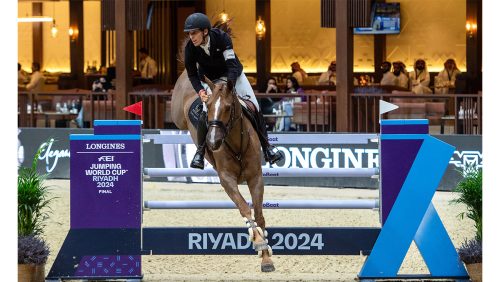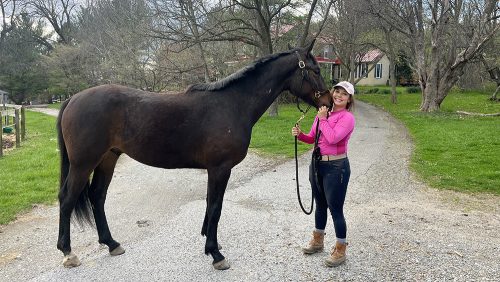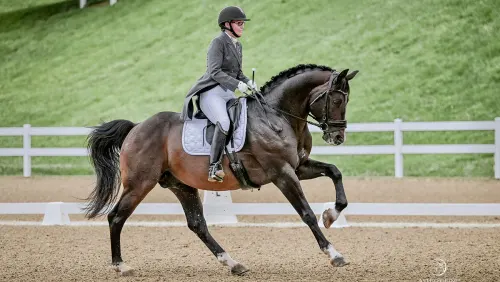Dear Rita,
Of the Four Ways Forward for Dressage in the USA— Training, Management, Logistics and Marketing—we have already talked about the training and coaching I hope to see for our team in the future. The U.S. team coach needs to work closely together with a team manager to help prepare future combinations for prolonged international competition.
2. Management and Preparation
How many riders in our country know the difference between fast twitch and slow twitch muscles, and how both relate to the performance of an equestrian athlete? How many of us know how to train and feed a developing Grand Prix horse to keep him fit until he has reached the very top level of competition and onward into his retirement? Can aqua training benefit your horse? Hard ground versus soft ground? Rice-based feed as opposed to oats?
How many riders have worked on training their own minds to focus with clarity and intensity during top competition? Your brain and your horse’s brain are bundles of nerve tissue that can be trained to respond to stimuli. That means that brains can be trained to increase concentration and performance under stress. The last 10 years have seen amazing advances in the science and technology used in equestrian sports.
We need contemporary support from a U.S. team manager who focuses on long term soundness and fitness through conditioning so that our riders can train with the intensity needed to get to the top of the sport. The team vet should not be called in after a team is selected just to get our horses through a vet check. He needs to be involved in management at a much earlier phase. We need information on how to shoe, train and feed our horses for a basic level of soundness that allows us to train and compete over extended periods of time with the intensity necessary to be successful.
When one of our top horses is injured, he needs to stay home and recover even if the timing means he will sit out an Olympics or WEG. If you have to treat, don’t compete.
Today’s top equine athlete not only has to pass the vet check, he has to be sound enough to train with intensity and increasing precision through all the required days of top events. In this sense, Britain, Germany and the Netherlands were the best managed and the best prepared teams at the London Olympics.
Take Adelinde Cornelisson and Parzival as an example. Parzival arrived at London fit, sound and ready to compete. He not only trained with vigor every day, but Adelinde also improved his performance in every single test to the point where they made a respectable challenge for the gold in the freestyle, even though Parzival arrived at the venue on a hair’s breadth of fitness. He had not been seen in CDI competition since April and had just one national competition as a preparation before the London Games due to an injury. How did Adelinde pull this off? Good management and preparation.
When a logistic plan is formed (see below) both the team manager and the team coach need to develop individual training plans for our horses to get them fit and keep them fit throughout the stress of travel, training and competition. Riders have to be fit in body and mind as well.
ADVERTISEMENT
The team manager should oversee information coming from the team coach, home trainer, vet, sports psychologist, fitness trainer, human and equine nutritionist, team farrier and team physio. And this needs to be done over YEARS, not a few weeks before an event.
3. Logistics and Planning
When our teams show up at European CDIOs in the future, they have to be seen performing at their very best under pressure. This means getting there early. Training with a goal. Choosing a few shows to build up to the bigger event. And having your best ride at your fingertips in the moment when you need it the most. Sadly, this kind of plan was missing from our London Olympic preparation.
Success takes advance planning. We need a chef d’equipe who starts with the goal competition (eg: Normandy 2014 and Rio De Janeiro 2016) and works backward to plan a good strategy for success.
Taking the Alltech FEI World Equestrian Games in Normandy, France, as an example, possible combinations need to be identified now while leaving the door open for up-and-coming horses. That takes one simple email survey conducted by either the team advisor, the chef d’equipe or the director of dressage. These combinations need to be evaluated by the team coach and team manager. Long-range plans need to be drawn up for training and competition, and these plans need to be supported by feeding, shoeing, conditioning and fitness training for both horse and rider—body and mind alike.
Shows need to be identified in the USA and Europe as preview competitions. Anyone wishing to be “discovered” should show up at them. The team coach needs to contact interesting pairs, communicate with them, and evaluate their potential for the team. Our High Performance Committee is many-numbered. Let’s ask this committee to elect a sub committee that sends two members to every CDI in the USA, just to evaluate potential international talent. Competitors stationed in Europe should be asked to post videos of their tests online. There is no excuse for failed communication in the Cyber Age.
Winter tours for 2012/2013 need to be established on each coast with qualifications for the U.S. National Championships. A short list should be developed out of the competition results in Florida and California over the winter, and Gladstone in the early summer. The short list should be sent over to Europe for three months in late summer/early fall for a development tour. Our horses and riders need experience and exposure to the European shows. Summer/fall of 2013 is a good, quiet time to get out to the smaller CDIs.
All riders, trainers and coaches should attend the European championships to study the competition and develop a better understanding of how the Grand Prix test is being ridden today. We need to work together, study together and advance together.
Winter Prep For Normandy
Winter of 2013/2014 must identify a stronger short list than the year before. And this should be accomplished at the CDIs in Florida and California from January-March. I hope that a set of three non-American international judges could be hired to do two shows on each coast, and that their scores could be statistically analyzed to see whom they favor. These should be judges from the jury in Normandy, including the head of the jury.
ADVERTISEMENT
American judges should be rotated at these CDIs, and they should be required to participate in an evaluation session with the top-placed riders and team coach after every show. I hope that these American judges would have consulted with European judges before the session. The statistical analysis and the judges’ evaluation needs to show our team the strengths and weaknesses of each pair so that our trainers and riders can work together in getting the scores up.
This short list of at least eight horses/riders needs to move to Europe in April of 2014. Horses and riders alike need to settle in and adjust to the food, the time zone and the bugs of Europe. This takes one to three weeks depending on the individual.
This short list needs to be split into an A and B Team with the teams alternating between the following shows:
April in Hagen, Germany (B Team)
May in Munich, Germany (A Team)
May in Hamburg, Germany (B Team)
June in Hickstead, England (A Team)
June in Rotterdam, the Netherlands (B Team)
July in Aachen, Germany (Top Six)
July in Falsterbo, Sweden (Low Two)
By July 15, we will be able to pick our strongest team for the WEG in Normandy, August-September 2014. And I hope that our team would be well prepared for success.
A plan for Rio de Janeiro would look much different than the one for the Normandy WEG because the goal competition (2016 Olympics in Brazil) is on a different continent. Our team needs to stay home in the winter of 2015/2016 and bring the competition to the USA so that we can test ourselves against them. Don’t raise your eyebrows at me, Rita, I have a plan for that too!
These are just examples of logistics that could work taken from the top of my head. I am sure that all the naysayers are already pointing out how financially impossible these outrageously expensive plans are. But you don’t succeed big when you dream small, Rita.
This kind of advanced planning must be done and in the greatest possible detail. When our plans are detailed, it is the job of the team fundraiser to make sure we can pay for them. Which will bring me to the next blog about Marketing and Finance.
I’m Catherine Haddad Staller, and I’m sayin it like I’m dreamin it from Vechta, Germany.
Training Tip of the Day: “At first, dreams seem impossible, then improbable, and eventually inevitable.” —Christopher Reeve















